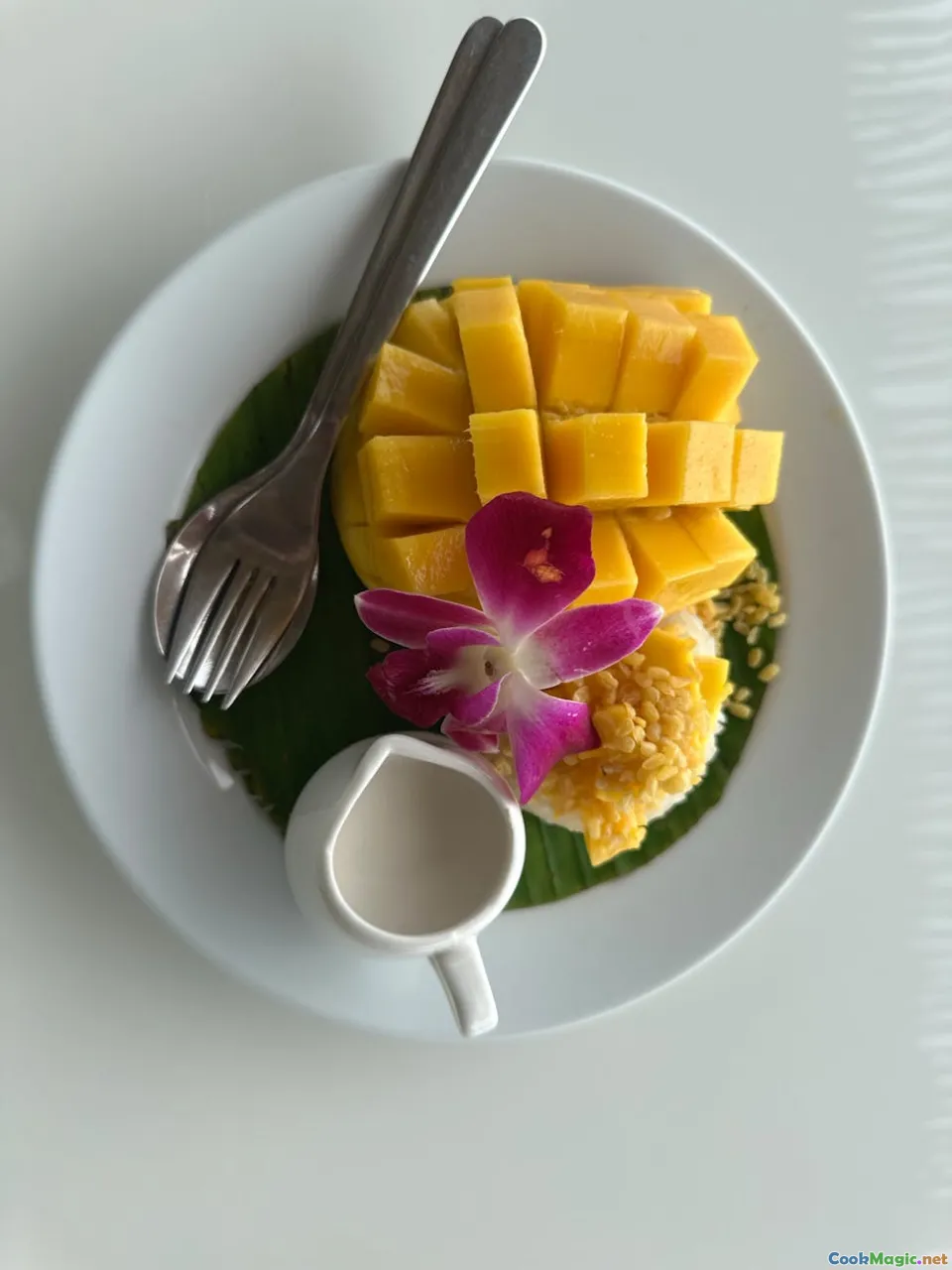
Smakowita Rozkosz z Kokosowym Ryzem Solo
(Savory Solo Coconut Rice Delight)
(0 Recenzje)0
366
lipiec 16, 2025
Zgłoś problem
Składniki
-
300 grams Ryż Jaśminowy
(Preferably authentic Indonesian variety)
-
400 ml Mleko kokosowe
(Use the thick, first press for richness)
-
200 ml Woda
-
300 grams Udka z kurczaka
(Boneless, cut into chunks)
-
2 leaves Liście Pandan
(Tied into a knot for fragrance)
-
2 stalks Trawa cytrynowa
(Bruised and tied)
-
2 leaves Liście laurowe
(Preferably Indonesian salam leaves)
-
2 cm piece Galangal
(Stłuczony)
-
4 cloves Szalotki
(Cienko pokrojony)
-
2 cloves Czosnek
(Mielony)
-
1 tsp Sól
(Dostosuj do smaku)
-
1 tsp Cukier
(Browns and balances flavors)
-
2 whole Jajka na twardo
(Do dekoracji)
-
100 grams Smażony tempeh
(Do dekoracji)
-
4 tbsp Serundeng (smażone wiórki kokosa)
(Do dekoracji)
-
2 tbsp smażone cebulki
(Do dekoracji)
-
2 whole Zielone chili
(For extra spice)
(Preferably authentic Indonesian variety)
(Use the thick, first press for richness)
(Boneless, cut into chunks)
(Tied into a knot for fragrance)
(Bruised and tied)
(Preferably Indonesian salam leaves)
(Stłuczony)
(Cienko pokrojony)
(Mielony)
(Dostosuj do smaku)
(Browns and balances flavors)
(Do dekoracji)
(Do dekoracji)
(Do dekoracji)
(Do dekoracji)
(For extra spice)
Wartości odżywcze
- Porcje: 4
- Wielkość porcji: 1 talerz (250 g)
- Calories: 550 kcal
- Carbohydrates: 65 g
- Protein: 16 g
- Fat: 22 g
- Fiber: 4 g
- Sugar: 5 g
- Sodium: 580 mg
- Cholesterol: 70 mg
- Calcium: 80 mg
- Iron: 3 mg
Instrukcje
-
1 - Prepare Aromatics:
Bruise the pandan leaves, lemongrass, and galangal. Thinly slice the shallots and mince the garlic.
-
2 - Saute Shallots and Garlic:
In a thick-bottomed pot, heat a splash of oil and saute shallots and garlic until fragrant and golden.
-
3 - Add Aromatics:
Add the pandan leaves, lemongrass, bay leaves, and bruised galangal into the pot. Saute briefly to release aroma.
-
4 - Combine Rice and Coconut Milk:
Add jasmine rice, coconut milk, and water into the pot. Stir in salt (and sugar if using). Mix well.
-
5 - Simmer the Rice:
Bring the mixture to a gentle simmer. Cover the pot, reduce heat, and cook until the rice absorbs the liquid and softens—about 20-25 minutes. Stir occasionally to prevent sticking.
-
6 - Add Chicken (Optional):
If using chicken, nestle the pieces into the rice halfway through cooking. Cover and allow them to steam until cooked through.
-
7 - Prepare Toppings:
Hard-boil the eggs, fry tempeh until golden, and toast coconut flakes for serundeng if not using pre-made. Set garnishes aside.
-
8 - Assemble and Serve:
Fluff the rice and remove aromatics. Serve onto plates and top with eggs, tempeh, serundeng, fried shallots, and a green chili for each serving.
Bruise the pandan leaves, lemongrass, and galangal. Thinly slice the shallots and mince the garlic.
In a thick-bottomed pot, heat a splash of oil and saute shallots and garlic until fragrant and golden.
Add the pandan leaves, lemongrass, bay leaves, and bruised galangal into the pot. Saute briefly to release aroma.
Add jasmine rice, coconut milk, and water into the pot. Stir in salt (and sugar if using). Mix well.
Bring the mixture to a gentle simmer. Cover the pot, reduce heat, and cook until the rice absorbs the liquid and softens—about 20-25 minutes. Stir occasionally to prevent sticking.
If using chicken, nestle the pieces into the rice halfway through cooking. Cover and allow them to steam until cooked through.
Hard-boil the eggs, fry tempeh until golden, and toast coconut flakes for serundeng if not using pre-made. Set garnishes aside.
Fluff the rice and remove aromatics. Serve onto plates and top with eggs, tempeh, serundeng, fried shallots, and a green chili for each serving.
Więcej o: Smakowita Rozkosz z Kokosowym Ryzem Solo
Nasi Liwet Solo Gurih: A Journey Into Java’s Rice Traditions
Summary
Nasi Liwet Solo Gurih is the epitome of Solo’s comfort food—rich, fragrant, and deeply artisanal. This savory rice dish, whose origins hail from the city of Solo (Surakarta) on the island of Java, takes humble white rice and transforms it into a festive centerpiece through the masterful layering of coconut milk and aromatic herbs. Every bite tells a story—creamy from the coconut, fresh from lemongrass and pandan, and earthy from the optional protein toppings.
History & Cultural Significance
Nasi liwet itself dates back centuries as both royal cuisine and humble home fare. Particularly in Solo, the dish gained traction as a favorite for communal meals and village celebrations. The secret lies in the sacred trinity of pandan, lemongrass, and coconut milk—a legacy from the Javanese philosophy of rukun (harmony) reflected through food. Traditionally, nasi liwet is enjoyed on banana leaves, eaten by hand, and shared amidst conversation. In Javanese culture, food is not just sustenance—it’s an invitation to togetherness.
For specific communities—like the Sesaji Dalem ceremonies—binding the kitchen smells of coconut and pandan into rice is tribute to ancestors and an act of celebration. Served most authentically with toppings like hard-boiled eggs, opor ayam (coconut chicken), tofu, tempeh, and serundeng, the dish is wonderfully adaptable across generations.
Unique Aspects
One of the most distinguishing features of Solo nasi liwet is the sticky, almost risotto-like texture. Unlike plain steamed rice, the grains slowly absorb the rich, spiced coconut milk, the flavor steeped through the aromatics for a truly soothing eating experience. Layers of fried toppings—tempeh, serundeng (toasted and spiced coconut), and crispy shallots—offer big contrasts in both flavor and texture.
Another Quintessential detail? The use of pandan and lemongrass. Pandan imparts a unique, sweet-floral scent that lifts the whole pot, while lemongrass’s citrus notes cut through the coconut’s intensity. If original daun salam (Indonesian bay leaves) can be found, they add a subtle earthy note otherwise missing from "regular" bay leaves.
Tips & Substitutions
- If jasmine or medium-grain rice isn’t available, sushi rice (rinsed) offers a similarly sticky result.
- Substitute chicken with mushrooms or tofu for a vegetarian adaptation.
- Store-bought fried onions save time, though making them fresh enhances authenticity.
- Do not skip pandan leaf if possible—it’s central for fragrance!
- Make in a rice cooker by combining all ingredients (apart from proteins), switching to 'cook' mode, and stirring after 10-15 minutes.
Serving
Nasi Liwet is best enjoyed hot, ladled onto banana leaves if available, and topped with whatever proteins or sambals fit your tastes. It pairs excellently with labu siam (chayote stew) and simple cucumber pickles for additional freshness.
Personal Thoughts
Every pot conjures a time-travel to Solo at dawn: the sizzle of spices, temple bells, and neighbors offering a shared meal. Try presenting the dish this way next communal gathering; its subtle warmth will garner surprise and delight. It’s food at its most unifying—proof that even the simplest grain, when honored and elevated, can tell a whole city’s story.
























